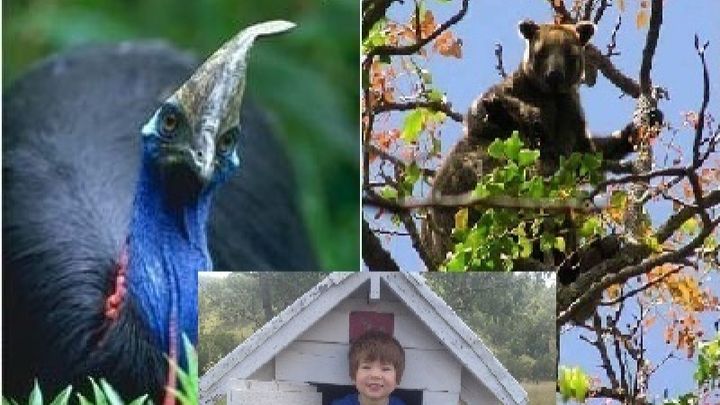
Save our dream, save our kidsfuture
Two endangered/vulnerable species, our dream and the mission to save both.
We are a family of three (3). We are like any other family - working hard, trying to saving hard and having dreams. But sometimes those dreams don’t go to plan and after a rough end to 2014, we are looking to new beginnings. After my husband broke his wrist and arm in an accident I was tasked with going back to full time work while he undertook 8-10 months of rehabilitation and became the watcher of our 3 year old son.
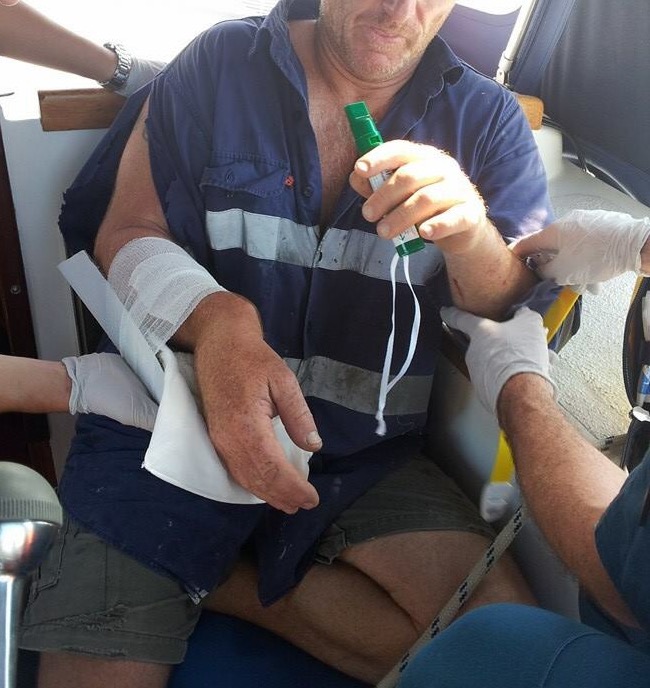
But let’s go back a bit …
In August 2013 my husband and I purchased a block of land in the Daintree area of northern Queensland, Australia. This block was going to give us our dream of building a small organic farm, living off the grid and having a sustainable lifestyle away from all the ‘normal world’ conveniences. After many, many months of researching the area and spending time at the block, we started to see animals that we didn’t know existed in that area. We have since discovered it is part of the natural habitat for many animals, such as tree frogs, bats, butterflies and marsupial species but it was the endangered/vulnerable species that caught our eye.
The block is 3 hectares (8 acres) of lush green rainforest with a natural seasonal watercourse running through the property. No power, no connected water, no dwellings, plenty of rainforest canopy, seasonal watercourse, natural habitat and corridor to the endangered Southern Cassowary and vulnerable Bennett’s tree kangaroo.
All we wanted was to create a farm that our son Jack could have later in life; that he could use to learn about the true rainforest elements of the Daintree; to know that it is possible to live without some of the modern conveniences we take for granted; that he could learn to garden, collect rainwater; and live off the land through his own means. It was also for us, as parents, to be able to provide these experiences and be able to hand it down to our son as he grew older. We are no greenies but value life outside of the many influences we face.
This land was our dream house, it was the future experiences for our child and it was our retirement fund.
When purchasing the block, and maybe through lack of research at the time, we didn’t know that the lowland rainforest area and indeed our block formed part of their habitat. In fact we had no idea about the rare biodiversity that existed within the lowlands of northern Australia and in particular the area where the block was.
Developments, changes in vegetation and disturbance of food matter and water over time has meant that their habitat is slowly decreasing and we did not want to be ‘just another person’ to contribute to their decline.
If we sell it, the problem is that someone else may not be too concerned with the above, they will treat it like residential land and the habitat and rare biodiversity of that area will be lost forever.
We want to save these species and their habitat as there are only 1000 Southern Cassowary left in Australia and a decreasing number of tree kangaroos. Why contribute more to their decline?
More information is provided below of the endangered species.
Unfortunately, we are not in a position (nor can we afford) to buy another block.
So this is what we are proposing ….
We have set ourselves a target to raise funds, so we can keep our dreams alive. When this target is reached we will donate full outright ownership of the block to a Daintree Rainforest Preservation company.
The company (a non-profit registered organisation) was set up to buy back 203 properties in the Daintree area by 2020. At present they have just 26. These properties are purchased in areas where development is threatening the pure nature of what they are trying to achieve. By purchasing blocks they can build conservation areas and maintain the equilibrium of the rainforest/lowlands area.
But wouldn’t it be great if they didn’t have to spend money to take ownership of the property and that people, such as our selves, are willing to contribute to the cause of saving the endangered species and the lowlands diversity of the Daintree area.
And here’s how you can help …
We are asking for donations so we can donate this land. We have thought of many different ways to raise the funds but hope we can find some kindness in people to help us achieve this.
By donating even the smallest amount you will help us achieve our dream and our goal of saving this land for future generations and for them to appreciate the natural wonders of the world.
When we donate full ownership, we will provide evidence of such and notify all our donors of the event and exact details of the transaction. This end transaction has been approved by the Rainforest Preservation company that we wil be using.
We appreciate every single person who contributes to our fund because it is with these people that will make our dreams finally come true.
Southern Cassowary
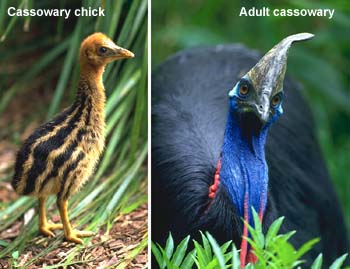
Common name: southern cassowary
Species name: Casuarius casuarius johnsonii
Family: Casuariidae (cassowaries and emus)
Conservation status:
The southern cassowary is listed as Endangered nationally (Environment Protection and Biodiversity Conservation Act 1999 (EPBC)).
Description:
Of three species of cassowaries in the world, only the southern cassowary, Casuarius casuarius johnsonii, is found in Australia. Like the emu and ostrich, the southern cassowary is a ratite, a large flightless bird with unusual feathers and other features that distinguish it from all other birds. A striking bird with glossy black plumage, the adult southern cassowary has a tall, brown casque (helmet) on top of its head, a vivid blue and purple neck, long drooping red wattles and amber eyes. The purpose of the tall helmet or casque is unknown but it may indicate dominance and age, as it continues to grow throughout life. Recent research indicates it may also assist cassowaries in "hearing" the low vibrating sound made by other cassowaries. The casque is spongy inside, rather than bony, and may also act as a shock-absorber that protects the bird’s head when it pushes through dense thickets of rainforest and scrub.
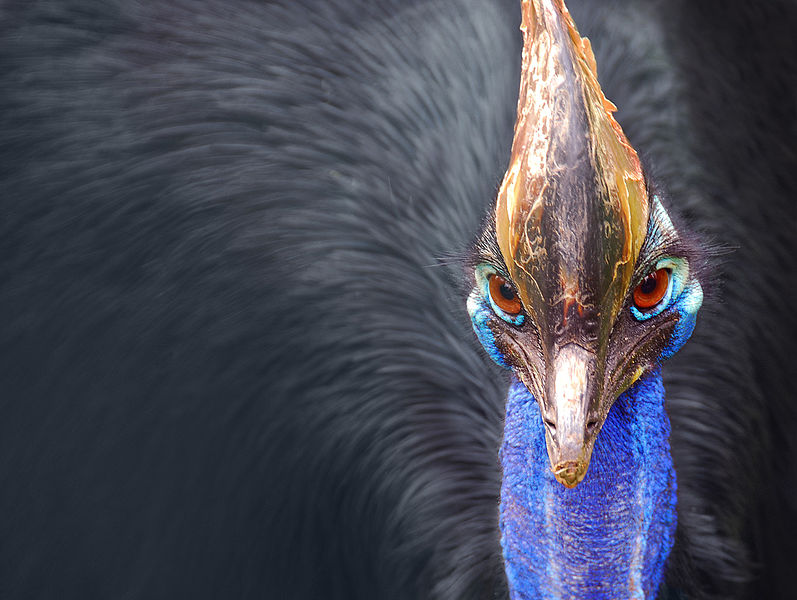
The cassowary has coarse hair-like feathers with no barbules, and also lacks tail feathers. Its wing stubs carry a small number of long, modified quills which curve around the body. Each heavy, well-muscled leg has three toes, with the inside toe bearing a large dagger-shaped claw (up to 120 mm long) used for scratching and fighting other birds.
Newly-hatched chicks are striped dark brown and creamy white. After three to six months the stripes fade and the plumage changes to brown. As the young mature, the plumage darkens, the wattles and casque develop and the skin colour on the neck and wattles brighten. Cassowaries reach maturity at about three years of age.
Adult cassowaries can grow to an imposing 2 m tall. In general, the sexes are fairly similar in appearance, though females are slightly larger and can weigh up to 76 kg. Males can weigh up to 55 kg.
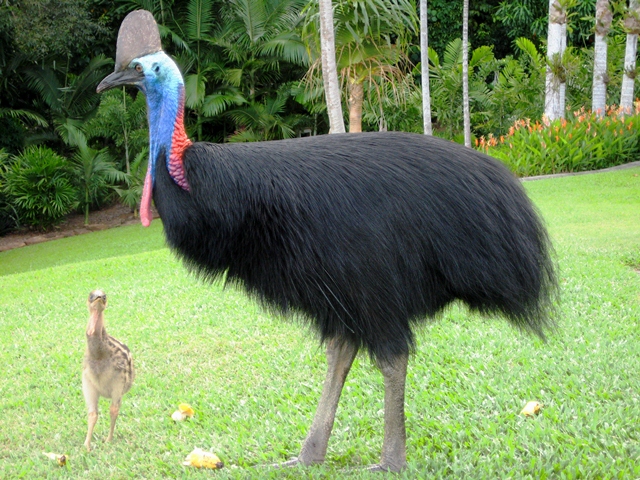
Habitat and distribution:
At the time of European settlement of Australia, the cassowary lived in tropical rainforests of north-east Queensland, from Paluma Range (north of Townsville) to the tip of Cape York. Cassowaries are now found in three broad populations. One population in the Wet Tropics and two populations in Cape York.
On Cape York, they now occur in two separate populations: a southern population in the vine forests of the McIlwraith and Iron ranges and a northern population in the less extensive vine forests north of Shelburne Bay.
In the Wet Tropics cassowaries are distributed widely from Cooktown to Paluma Range. Approximately 89% of their remaining essential habitat in the Wet Tropics lies within protected tenures. Cassowary habitat in the Wet Tropics have been greatly reduced by land clearing, so cassowary numbers have decreased.
Cassowaries require a high diversity of fruiting trees to provide a year-round supply of fleshy fruits. Although occurring primarily in rainforest, they also use woodlands, melaleuca swamps, mangroves and even beaches, both as intermittent food sources and as connecting habitat between more suitable sites. Places with a mix of these environments are preferred by cassowaries that live near the coast.
Threatening processes:
A number of factors affect cassowary survival. The major threats include the loss, fragmentation and modification of habitat, vehicle strikes, dog attacks, human interactions, pigs, disease and natural catastrophic events.
Cassowary habitat, particularly on the coastal lowlands, has been seriously reduced by land clearing for farming, urban settlement and other development. Urban development continues to threaten the populations that occur outside protected areas.
In the Mission Beach area, road accidents are the greatest single cause of cassowary death. Roads cut through cassowary territories, making it necessary for the birds to travel across them when looking for food. Birds can also be attracted to roads by people feeding them or throwing litter from vehicles.
Unrestrained and wild dogs are another major cause of cassowary deaths, particularly in areas near residential development. Chicks and sub-adults are small enough to be killed by dogs. However, packs of dogs also kill adult birds, pursuing them until they are exhausted, then attacking them. Dogs also indirectly affect cassowaries through their very presence, influencing the feeding, movements and general behaviour of the birds. Domestic dogs can also attack and kill cassowaries when they wander into suburban areas seeking food or water.
Pigs cause disturbance to the rainforest and compete with cassowaries for fallen fruit. They may also eat cassowary eggs and destroy nests. Pig control activities may also be hazardous to cassowaries, particularly when dogs are let loose to hunt pigs, and end up finding and attacking cassowaries instead.
Hand-feeding of cassowaries is a risk to both birds and people. Wild cassowaries conditioned to human food sources can be aggressive when protecting themselves or their chicks, or seeking other human food. As birds become less wary of humans, they may become more vulnerable to dog attack and road mortality as they move around looking for food.
In recent years, cyclones have damaged large areas of cassowary habitat, causing temporary food shortages. This may have placed further stresses on local populations already under threat from habitat fragmentation, dogs and vehicle strikes.
Bennetts Tree Kangaroo
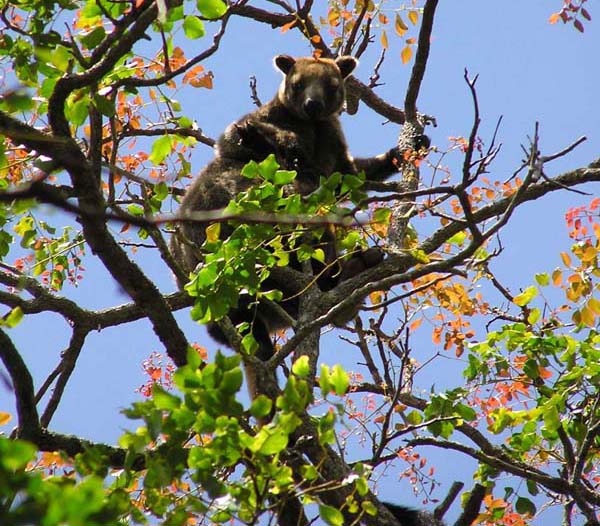 Yes - ths is an endangered Bennett's Tree Kangaroo
Yes - ths is an endangered Bennett's Tree Kangaroo
Common name: Bennett’s Tree Kangaroo
Species name: Bennettianus
Family: Macropodidae
Status: Critically endangered
Physical Description:
Bennett's Tree-kangaroo is mostly dark brown above and lighter brown on the chin, throat and underside. The top of their head and shoulders is reddish brown The forehead and snout are grey. The feet are black. The tail is black near the base and is lighter brown above. The ears are short and rounded. Bennett's Tree-kangaroo is very agile and can jump 9m from branch to branch, and drop 18m to the ground without injury. They walk on all fours when on the ground, or hop on their hind feet.
Size:
Length: 41-77cm
Tail length: 40-87cm
Weight: up to 14.5kg
Habitat:
Montane tropical forest
Range States:
North Queensland from south of Cooktown to just north of the Daintree River
Population & Distribution:
Tree kangaroos have suffered from loss of habitat, and many species have suffered severe reductions in their range. The Wondiwoi tree kangaroo is critically endangered (possibly extinct) with as few as 50 individuals remaining. Similarly, the critically endangered dingiso has suffered a population decline in excess of 80% over the last 30 years.
Diet:
Living in the trees, the tree kangaroo eats mostly leaves and fruit, although they will also collect fruit that has fallen to the ground. The animals will also eat other items such as grains, flowers, sap, eggs, young birds, and even bark.
Main Threats:
The major threats facing tree kangaroo species are hunting and habitat loss.
Tree kangaroos have been hunted for food by indigenous communities across their range. For a number of species, this factor alone has contributed to a sharp decline in population numbers.
Habitat loss and degradation means that many species now inhabit a restricted range. Habitat has been removed for logging and timber production, or converted to coffee, rice or wheat production. This loss of habitat can also expose tree kangaroos to predation by domestic dogs.
Reference: www.ozanimals.com.au & http://wwf.panda.org/
Interesting Tree Kangaroo Facts
· Tree kangaroos are slow in reacting as well as awkward on the ground.
· These species hop around but at a walking pace; however, they are far more lithe and quick in trees.
· They are also exceptional jumpers with some jumps recorded to be 9 meters (30 feet) in the downward direction from one tree to another.
· Tree kangaroos are adept to jump to the ground from 18 m (59 ft) or more.
· They have robust legs and forelimbs that help them in climbing up the tree very easily.
· A tree kangaroo exhibits a dense reddish brown fur as well as bright band that run along its back.
· The length of tree kangaroo measures around 41 – 77 cm (16 – 30 inches) excluding tail.
· The tail is 40 – 87 cm (16 – 34 inches) long.
· The females are smaller than males.
· Tree kangaroos weigh around 14.5 kg (32 lb).
· They have dark red feet, ears, and stomach.
· The tree kangaroo tail helps him to maintain a balance.
· These kangaroos are solitary animals and they only congregate while mating.
· The population of tree kangaroos is facing rapid decline due to undue habitat destruction, oil exploration, mining, and farming. Because of these acts, these species are more readily preyed on by wild dogs. Besides habitat destruction, tree kangaroos have also been hunted in order to meet the native people’s needs. They are hunted mainly for meat.
Reference: http://animalstime.com/tree-kangaroo-facts-follow-me-for-tree-kangaroo-diet-habitat/
We are a family of three (3). We are like any other family - working hard, trying to saving hard and having dreams. But sometimes those dreams don’t go to plan and after a rough end to 2014, we are looking to new beginnings. After my husband broke his wrist and arm in an accident I was tasked with going back to full time work while he undertook 8-10 months of rehabilitation and became the watcher of our 3 year old son.

But let’s go back a bit …
In August 2013 my husband and I purchased a block of land in the Daintree area of northern Queensland, Australia. This block was going to give us our dream of building a small organic farm, living off the grid and having a sustainable lifestyle away from all the ‘normal world’ conveniences. After many, many months of researching the area and spending time at the block, we started to see animals that we didn’t know existed in that area. We have since discovered it is part of the natural habitat for many animals, such as tree frogs, bats, butterflies and marsupial species but it was the endangered/vulnerable species that caught our eye.
The block is 3 hectares (8 acres) of lush green rainforest with a natural seasonal watercourse running through the property. No power, no connected water, no dwellings, plenty of rainforest canopy, seasonal watercourse, natural habitat and corridor to the endangered Southern Cassowary and vulnerable Bennett’s tree kangaroo.
All we wanted was to create a farm that our son Jack could have later in life; that he could use to learn about the true rainforest elements of the Daintree; to know that it is possible to live without some of the modern conveniences we take for granted; that he could learn to garden, collect rainwater; and live off the land through his own means. It was also for us, as parents, to be able to provide these experiences and be able to hand it down to our son as he grew older. We are no greenies but value life outside of the many influences we face.
This land was our dream house, it was the future experiences for our child and it was our retirement fund.
When purchasing the block, and maybe through lack of research at the time, we didn’t know that the lowland rainforest area and indeed our block formed part of their habitat. In fact we had no idea about the rare biodiversity that existed within the lowlands of northern Australia and in particular the area where the block was.
Developments, changes in vegetation and disturbance of food matter and water over time has meant that their habitat is slowly decreasing and we did not want to be ‘just another person’ to contribute to their decline.
If we sell it, the problem is that someone else may not be too concerned with the above, they will treat it like residential land and the habitat and rare biodiversity of that area will be lost forever.
We want to save these species and their habitat as there are only 1000 Southern Cassowary left in Australia and a decreasing number of tree kangaroos. Why contribute more to their decline?
More information is provided below of the endangered species.
Unfortunately, we are not in a position (nor can we afford) to buy another block.
So this is what we are proposing ….
We have set ourselves a target to raise funds, so we can keep our dreams alive. When this target is reached we will donate full outright ownership of the block to a Daintree Rainforest Preservation company.
The company (a non-profit registered organisation) was set up to buy back 203 properties in the Daintree area by 2020. At present they have just 26. These properties are purchased in areas where development is threatening the pure nature of what they are trying to achieve. By purchasing blocks they can build conservation areas and maintain the equilibrium of the rainforest/lowlands area.
But wouldn’t it be great if they didn’t have to spend money to take ownership of the property and that people, such as our selves, are willing to contribute to the cause of saving the endangered species and the lowlands diversity of the Daintree area.
And here’s how you can help …
We are asking for donations so we can donate this land. We have thought of many different ways to raise the funds but hope we can find some kindness in people to help us achieve this.
By donating even the smallest amount you will help us achieve our dream and our goal of saving this land for future generations and for them to appreciate the natural wonders of the world.
When we donate full ownership, we will provide evidence of such and notify all our donors of the event and exact details of the transaction. This end transaction has been approved by the Rainforest Preservation company that we wil be using.
We appreciate every single person who contributes to our fund because it is with these people that will make our dreams finally come true.
Southern Cassowary

Common name: southern cassowary
Species name: Casuarius casuarius johnsonii
Family: Casuariidae (cassowaries and emus)
Conservation status:
The southern cassowary is listed as Endangered nationally (Environment Protection and Biodiversity Conservation Act 1999 (EPBC)).
Description:
Of three species of cassowaries in the world, only the southern cassowary, Casuarius casuarius johnsonii, is found in Australia. Like the emu and ostrich, the southern cassowary is a ratite, a large flightless bird with unusual feathers and other features that distinguish it from all other birds. A striking bird with glossy black plumage, the adult southern cassowary has a tall, brown casque (helmet) on top of its head, a vivid blue and purple neck, long drooping red wattles and amber eyes. The purpose of the tall helmet or casque is unknown but it may indicate dominance and age, as it continues to grow throughout life. Recent research indicates it may also assist cassowaries in "hearing" the low vibrating sound made by other cassowaries. The casque is spongy inside, rather than bony, and may also act as a shock-absorber that protects the bird’s head when it pushes through dense thickets of rainforest and scrub.

The cassowary has coarse hair-like feathers with no barbules, and also lacks tail feathers. Its wing stubs carry a small number of long, modified quills which curve around the body. Each heavy, well-muscled leg has three toes, with the inside toe bearing a large dagger-shaped claw (up to 120 mm long) used for scratching and fighting other birds.
Newly-hatched chicks are striped dark brown and creamy white. After three to six months the stripes fade and the plumage changes to brown. As the young mature, the plumage darkens, the wattles and casque develop and the skin colour on the neck and wattles brighten. Cassowaries reach maturity at about three years of age.
Adult cassowaries can grow to an imposing 2 m tall. In general, the sexes are fairly similar in appearance, though females are slightly larger and can weigh up to 76 kg. Males can weigh up to 55 kg.

Habitat and distribution:
At the time of European settlement of Australia, the cassowary lived in tropical rainforests of north-east Queensland, from Paluma Range (north of Townsville) to the tip of Cape York. Cassowaries are now found in three broad populations. One population in the Wet Tropics and two populations in Cape York.
On Cape York, they now occur in two separate populations: a southern population in the vine forests of the McIlwraith and Iron ranges and a northern population in the less extensive vine forests north of Shelburne Bay.
In the Wet Tropics cassowaries are distributed widely from Cooktown to Paluma Range. Approximately 89% of their remaining essential habitat in the Wet Tropics lies within protected tenures. Cassowary habitat in the Wet Tropics have been greatly reduced by land clearing, so cassowary numbers have decreased.
Cassowaries require a high diversity of fruiting trees to provide a year-round supply of fleshy fruits. Although occurring primarily in rainforest, they also use woodlands, melaleuca swamps, mangroves and even beaches, both as intermittent food sources and as connecting habitat between more suitable sites. Places with a mix of these environments are preferred by cassowaries that live near the coast.
Threatening processes:
A number of factors affect cassowary survival. The major threats include the loss, fragmentation and modification of habitat, vehicle strikes, dog attacks, human interactions, pigs, disease and natural catastrophic events.
Cassowary habitat, particularly on the coastal lowlands, has been seriously reduced by land clearing for farming, urban settlement and other development. Urban development continues to threaten the populations that occur outside protected areas.
In the Mission Beach area, road accidents are the greatest single cause of cassowary death. Roads cut through cassowary territories, making it necessary for the birds to travel across them when looking for food. Birds can also be attracted to roads by people feeding them or throwing litter from vehicles.
Unrestrained and wild dogs are another major cause of cassowary deaths, particularly in areas near residential development. Chicks and sub-adults are small enough to be killed by dogs. However, packs of dogs also kill adult birds, pursuing them until they are exhausted, then attacking them. Dogs also indirectly affect cassowaries through their very presence, influencing the feeding, movements and general behaviour of the birds. Domestic dogs can also attack and kill cassowaries when they wander into suburban areas seeking food or water.
Pigs cause disturbance to the rainforest and compete with cassowaries for fallen fruit. They may also eat cassowary eggs and destroy nests. Pig control activities may also be hazardous to cassowaries, particularly when dogs are let loose to hunt pigs, and end up finding and attacking cassowaries instead.
Hand-feeding of cassowaries is a risk to both birds and people. Wild cassowaries conditioned to human food sources can be aggressive when protecting themselves or their chicks, or seeking other human food. As birds become less wary of humans, they may become more vulnerable to dog attack and road mortality as they move around looking for food.
In recent years, cyclones have damaged large areas of cassowary habitat, causing temporary food shortages. This may have placed further stresses on local populations already under threat from habitat fragmentation, dogs and vehicle strikes.
Bennetts Tree Kangaroo
 Yes - ths is an endangered Bennett's Tree Kangaroo
Yes - ths is an endangered Bennett's Tree KangarooCommon name: Bennett’s Tree Kangaroo
Species name: Bennettianus
Family: Macropodidae
Status: Critically endangered
Physical Description:
Bennett's Tree-kangaroo is mostly dark brown above and lighter brown on the chin, throat and underside. The top of their head and shoulders is reddish brown The forehead and snout are grey. The feet are black. The tail is black near the base and is lighter brown above. The ears are short and rounded. Bennett's Tree-kangaroo is very agile and can jump 9m from branch to branch, and drop 18m to the ground without injury. They walk on all fours when on the ground, or hop on their hind feet.
Size:
Length: 41-77cm
Tail length: 40-87cm
Weight: up to 14.5kg
Habitat:
Montane tropical forest
Range States:
North Queensland from south of Cooktown to just north of the Daintree River
Population & Distribution:
Tree kangaroos have suffered from loss of habitat, and many species have suffered severe reductions in their range. The Wondiwoi tree kangaroo is critically endangered (possibly extinct) with as few as 50 individuals remaining. Similarly, the critically endangered dingiso has suffered a population decline in excess of 80% over the last 30 years.
Diet:
Living in the trees, the tree kangaroo eats mostly leaves and fruit, although they will also collect fruit that has fallen to the ground. The animals will also eat other items such as grains, flowers, sap, eggs, young birds, and even bark.
Main Threats:
The major threats facing tree kangaroo species are hunting and habitat loss.
Tree kangaroos have been hunted for food by indigenous communities across their range. For a number of species, this factor alone has contributed to a sharp decline in population numbers.
Habitat loss and degradation means that many species now inhabit a restricted range. Habitat has been removed for logging and timber production, or converted to coffee, rice or wheat production. This loss of habitat can also expose tree kangaroos to predation by domestic dogs.
Reference: www.ozanimals.com.au & http://wwf.panda.org/
Interesting Tree Kangaroo Facts
· Tree kangaroos are slow in reacting as well as awkward on the ground.
· These species hop around but at a walking pace; however, they are far more lithe and quick in trees.
· They are also exceptional jumpers with some jumps recorded to be 9 meters (30 feet) in the downward direction from one tree to another.
· Tree kangaroos are adept to jump to the ground from 18 m (59 ft) or more.
· They have robust legs and forelimbs that help them in climbing up the tree very easily.
· A tree kangaroo exhibits a dense reddish brown fur as well as bright band that run along its back.
· The length of tree kangaroo measures around 41 – 77 cm (16 – 30 inches) excluding tail.
· The tail is 40 – 87 cm (16 – 34 inches) long.
· The females are smaller than males.
· Tree kangaroos weigh around 14.5 kg (32 lb).
· They have dark red feet, ears, and stomach.
· The tree kangaroo tail helps him to maintain a balance.
· These kangaroos are solitary animals and they only congregate while mating.
· The population of tree kangaroos is facing rapid decline due to undue habitat destruction, oil exploration, mining, and farming. Because of these acts, these species are more readily preyed on by wild dogs. Besides habitat destruction, tree kangaroos have also been hunted in order to meet the native people’s needs. They are hunted mainly for meat.
Reference: http://animalstime.com/tree-kangaroo-facts-follow-me-for-tree-kangaroo-diet-habitat/
Organizer
Megan Pettitt
Organizer
Murarrie, QLD